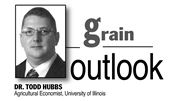|
A Positive Outlook for Corn

A strengthening trend in corn consumption, smaller corn acreage, and the developing production issues in South America signify a positive outlook for corn in 2018. The expectations for corn in the 2018 crop year put forth in this analysis show lower production leading to decreased ending stocks in 2018-19. While the big ending stocks projected for this marketing year continue to hang over corn prices, an upward price movement in corn during 2018 appears likely under a reduced production scenario.
Corn consumption currently is showing signs of building strength in exports, ethanol production, and other domestic uses. As 2018 progresses, an expectation of continued growth in corn consumption is the baseline for this analysis. 2018-19 marketing year expectations for consumption exceed projected production, which leads to a lower level of ending stocks by the end of the marketing year. Corn exports will be influenced by trade policy, world corn production, and economic growth. While changes in trade policy may impact corn exports over the next year, the following analysis assumes a minimal impact due to trade disruptions. Corn export projections by the USDA for the current marketing year sit at 2.05 billion bushels. Current production issues in South America and the competitiveness of U.S. corn export prices increase the probability of exceeding the current USDA marketing year projection. Current corn production projections for Brazil (3.7 billion bushels) and Argentina (1.53 billion bushels) appear likely for downward revisions in the upcoming USDA reports due to adverse weather. The potential for 400 million fewer bushels is increasingly probable in the two major South American countries. With a revision in South American production, world production projections come in approximately 4.5 percent lower in 2018. Building on the strength expected in export markets for the remainder of this marketing year, 2018-19 corn export projections in this analysis sits at 2.025 billion bushels.
Corn used for ethanol production during this marketing year continues to show tremendous consumption potential. Through February 28, an estimate of corn use for ethanol places use slightly above 2.8 billion bushels. An expectation of small increases in gasoline consumption in 2018 and 2019 combined with growth in the ethanol trade balance provide support to the continued increase in corn used for ethanol. Corn used for ethanol expectations increase to 5.57 billion bushels in the 2018-19 marketing year. An assumption of moderate growth in other domestic uses for corn is projected for next marketing year. Total food, seed, and industrial use projections come in at 7.065 billion bushels.
The pace of corn consumption for feed appears set to pull back from recent growth in the 2018-19 marketing year. Livestock production growth over the last few years will moderate and reduce corn feed use during the upcoming marketing year. Recent increases in soybean meal prices combined with increased distiller's grain availability portray a mixed picture for corn use. Increased availability of feed grains across the board may suppress some corn feed use. Residual use of corn could be reduced if the 2018 crop is smaller than the 2017 level. Feed and residual use is projected down slightly at 5.25 billion bushels. Overall, corn consumption shows moderate growth in the 2018-19 marketing year. Total consumption is projected at 14.6 billion bushels and may outpace domestic production.
Current market consensus projects farmers to plant fewer corn acres in 2018 than the 90.2 million acres planted last year. The current profitability advantage for soybeans over corn along with stronger prices in other crops create an incentive to reduce corn acres. The USDA Outlook Forum projected 2018 corn acres at 90.0 million acres. Various estimates from trade analysts set corn acreage in a range of 89 - 92 million acres. In this analysis, a reduction of corn acreage is expected. Planted acreage at 89.5 million acres would lead to around 82.2 million acres harvested for grain in 2018.
Yield expectations typically use trend yield analysis to generate yield projections for the next crop year. National average corn yield came in above trend for the last four growing seasons and culminated in an estimated 176.6 bushels per acre in 2017. Using a linear trend of actual U.S. corn average yields from 1960 forward, the trend estimate for 2018 is 168.6 bushels per acre. By adjusting the trend estimation for weather influences and recent trend deviations, we generate a national corn yield expectation of 172.3 bushels per acre. At this yield level, the 2018 crop projection is 14.2 billion bushels. By including the current projections for ending stocks of 2.36 billion bushels with 50 million bushels of imported corn, the 2018 corn supply comes in at 16.6 billion bushels. The 2018 corn supply estimate is 332 million bushels less than the current marketing year supply estimation.
The potential for lower corn acreage in 2018 combined with an increased consumption scenario presents a positive outlook for corn prices in 2018. While the corn price will continue to struggle with ending stocks, an upward price movement in corn during 2018 appears likely. Current expectations for corn consumption in the 2018-19 marketing year are 14.6 billion bushels. Ending stocks would be 2.00 billion bushels, which is 350 million bushels lower than the current marketing year projection. Based on this analysis of corn production and consumption, season average market price comes in at a range of $3.50 – $3.60 for the 2018-19 marketing year. ∆
DR. TODD HUBBS: Agricultural Economist, University of Illinois
|
|